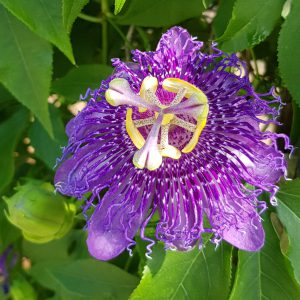There is a passionflower for every Central Florida yard; they attract butterflies, some have showy flowers, and some types even have edible fruit! Most passionflowers are vines. Compact species can be planted in small yards to take advantage of vertical growing space, while other species that tend to sprawl can be used to cover a fence or pergola. Many Floridians grow passionflowers in the landscape as ornamentals or edibles and there is even some small-scale production of passionfruit in South Florida.
Passionflowers attract a variety of pollinating insects. In Central Florida, some passionflower species attract Gulf Fritillary and Zebra Longwing butterflies, whose caterpillars exclusively feed on

passionflower leaves. Here are a few passionflower species to try in your Florida yard:
- Maypop (Passiflora incarnata) – This is the most common and vigorous Florida native passionflower. The large, gorgeous flowers will attract many butterflies, and the leaves will feed butterfly caterpillars. Maypop has edible fruits, and a tea can be made from the leaves. In urban landscapes, it may be best suited for growing in a container with a sturdy trellis to climb; it will quickly spread from the roots if it’s planted in the ground. The vine will die back in cold weather and regrow in the spring.
- Yellow passionflower (Passiflora lutea) – This native is easily grown in small yards, and has lovely, little flowers spring-fall.
- Corkystem passionflower (Passiflora suberosa) – This native is the smallest of the passionflower vines and is well-suited for growing in small spaces or containers. It has tiny flowers and will not be the focal point of the garden, but it will bring in the Gulf Fritillaries!
- Pale passionflower (Passiflora pallens) – This beautiful, endangered Florida native is available through native plant nurseries. This passionflower is a good ornamental plant in with it’s showy, fragrant flowers. It is easy to maintain in a small flower bed with a trellis to climb. Butterfly caterpillars will not feed on this species.
- Yellow passionflower (Passiflora edulis flavicarpa) – This species can be grown in Central Florida for fruit production. Note: This plant has the same common name as one listed above; use scientific names to find the plants you want. To produce fruit, it may be necessary to have two different varieties of this species for cross-pollination. Most varieties will produce fruit late summer-fall. Insulate vine bases during freezing temperatures. This species has a productive lifespan of a few years. Learn about growing passionflower for food in the home landscape.
Growing Passionflowers
 There are hundreds of species of passionflower. Be cautious before planting unknown species, as some can become invasive, and some are simply not suitable for Central Florida’s climate. Passionflower vines must have well-drained soil, but need regular irrigation. Plant passionflowers in a sunny location. Have a suitable trellis for the plants to grow up.
There are hundreds of species of passionflower. Be cautious before planting unknown species, as some can become invasive, and some are simply not suitable for Central Florida’s climate. Passionflower vines must have well-drained soil, but need regular irrigation. Plant passionflowers in a sunny location. Have a suitable trellis for the plants to grow up.
Some non-native passionflowers grown for fruit may become invasive if they are not maintained appropriately. Avoid growing those vines on tall fences, property lines, or up trees so they can be pruned back easily and dropped fruits can be collected. Fruiting species should be fertilized monthly in the warm months. Vines grown for fruit need to be pruned back in spring to encourage new stem growth, where the fruit is borne. Passionflowers are mostly pollinated by bees; protect pollinators by avoiding pesticide use when plants are blooming.
Enjoying passionfruit
All passionflowers produce fruit, but not all fruits taste good and some are actually toxic to humans. Don’t consume fruits or other plant parts without confirming the plant species and suitability for food.
Harvest passionfruit when it is the color that the species is supposed to be when ripe. Let it sit a few days until the skin is wrinkled. To eat passionfruit, cut open the shell and scoop out the seeds. The juicy, yellow pulp surrounding the seeds is actually the tasty part of the fruit. Seeds can be eaten with the pulp, strained out with a mesh strainer or use a blender on “pulse” to separate seeds from pulp and then strain. Passionfruit juice can be used in beverages, desserts and jellies.
For more information on gardening and farming, or sourcing plants, contact the UF IFAS Extension-Osceola County: 321-697-3000, or your local Extension office.
 1
1
